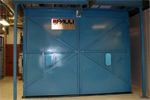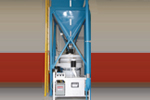Media Blasting & Dry Paint Stripping Facilities - Fighter jets & helicopters at Hellenic Aerospace Industry (HAI) / Lockheed-Martin
One of the world's most modern plastic media blasting (PMB) facilities with cutting edge technologies that protect the environment and reduce costs
|
Power Point presentation with more information about the Pauli Systems Media Blasting & Dry Paint Stripping Facility for Hellenic Aerospace Industry (HAI) / Lockheed-Martin
Download (PPT - 5.43MB)
Lockheed-Martin testimonial
“…Pauli Systems…demonstrated the highest level of integrity in all phases of the project, that the project was delivered on time, on budget and with an extraordinary level of quality in the products and services provided .”
-- David C. Rondeau Manager, International Industrial Cooperation
Read the full Lockheed Martin testimonial
Download (PDF - 75KB)
Learn more about Pauli Media Blasting Rooms, Reclaimable Abrasive Machine (RAM™) Dense Particle Separators, and RAM™ Dust Collectors
Download (PDF - 533KB)
Aerospace Media Blasting Room Brochure
Download (PDF 8.68 MB)
Get Adobe Reader
 F-16 before Stripping  F-16 After Stripping |
|
During stripping, process media is contaminated with paint particles from the aircraft, sand and debris from the ramp area, bits of tape and paper, metal flakes and so on. The reclaim section of a dry paint stripping facility must remove these contaminants from usable blast media, returning only clean media to the blast generators supplying the stripping nozzles.
This Pauli facility reclaims media via a rigorous series of processes including:
- Centrifugal separation via latest generation high-velocity cyclone. This eliminates much of the “fines,” the unusable small, light particles.
- Air wash separation with exclusive dual-adjustment (via independent adjustment of air wash velocity and volume) to fine tune the point at which fines are further separated and removed.
- Magnetic separator to remove ferrous particles.
- Ionization to prevent particles from agglomerating.
- Vibratory screen separation, a mechanical separation using gyrating screens to remove both oversize and under size particles from the working mix.
- Correctly sized material leaving the vibratory separator now consists of reusable blast media and dense particle contaminants such as sand and metal.
- Removing these contaminants is the job of the final stage of separation.
- Dense Particle Separation. This is important because dense contaminants may be harmful to aircraft structure and must be removed to generally, a level no greater than 0.02%. This is the job of the Dense Particle Separator (DPS). Pauli Systems patented DPS works with unparalleled efficiency due to its exclusive fluidized bed, microprocessor control, and operational independence from Operator input, humidity, temperature, altitude and a multitude of variables that affect other systems. The Pauli DPS has documented success over a huge range of aerospace customers and has published its findings. The Pauli DPS is a purpose-designed, supremely reliable engineering marvel that quietly does it job 24/7. This is not an agricultural seed/stone separator, but “the real deal.”
 Hellenic Exhaust plenums (in white), supervisor control room window (center), blast hoses (laid out on floor, parallel to themedia recovery troughs) & portable stripping unit (blue, in therear right)  Aircraft media blasting stripping facility supervisors control process parameters (media flow rate and nozzle air pressure) |
|



